Part I The 60th Anniversary of Japan's ODA: Its Achievements and Future Directions
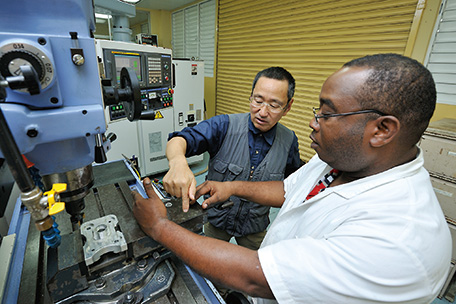
A Senior Volunteer, Mr. Seiki Nagata, teaching maintenance and machinery repair at the Technical Education & Vocational Training Authority in the Dominican Republic (Photo: Koji Sato / JICA)
Chapter 1 The Track Record of Japan's ODA
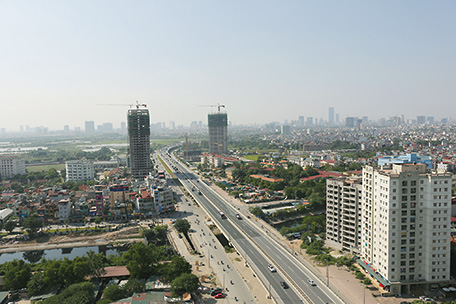
Hanoi City Ring Road No. 3 in Viet Nam helps improve transportation facilities and reduce traffic congestion. (Photo: Satoshi Takahashi / JICA)
Section 1 The Trajectory of Japan's ODA
Sixty years have passed since the start of Japan's technical cooperation to Asian countries after joining the Colombo Plan(Note 1) in 1954. Over the past 60 years, from shortly after World War II ended, through Japan's high economic growth period and until the present day, Japan's ODA has played a significant role in Japan's contribution to regional and global issues as a responsible member of the international community in establishing peace and prosperity of Japan. This section takes a look back at the history of the 60 years of Japan's ODA.
1. The Beginning of Japan's ODA (1950s-1960s)
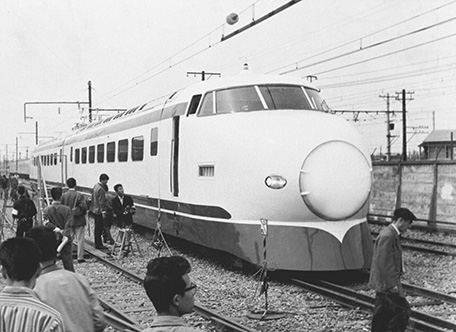
In 1962, a prototype train for the Tokaido Shinkansen Line (class 1000) was completed and displayed to the public at a Japanese National Railways facility in Kawaguchi City, Saitama Prefecture. (Photo: Kyodo News)
During the early years, most of Japan's ODA was implemented in parallel with postwar settlements in the form of reparation payments. The Agreement on Reparations and Economic Cooperation was signed with the Union of Burma (now Myanmar) in 1954. This was followed by the signing of reparation agreements with the Philippines, Indonesia, and the Republic of Viet Nam (South Viet Nam). As part of Japan's postwar settlements, economic cooperation and other supports were extended to Cambodia and Laos, which relinquished their rights to reparations from Japan, as well as to Thailand, Malaysia, Singapore, the Republic of Korea, and the Federated States of Micronesia. At the same time, Japan began to provide economic cooperation that was unassociated with postwar reparations, including technical cooperation through the aforementioned Colombo Plan, along with ODA loans, the first of which was provided to India in 1958. The provision of economic cooperation in parallel with reparations was expected not only to help with the implementation of postwar settlements, and in turn, improve relations with neighboring Asian countries and elevate Japan's international status, but also to contribute to the revival and growth of the Japanese economy by expanding the export market.
At this time though, Japan was still a recipient of foreign aid. Japan received U.S. assistance since the period of postwar occupation. From the 1950s through the 1960s, Japan borrowed funds from the World Bank for the development of many sectors, such as the steel, automobile, shipbuilding, electricity, and road sectors. Infrastructures familiar to the Japanese people, such as the Tokaido Shinkansen, the Tomei and Meishin Expressways, and the “Kurobe Dam(Note 2),” were built with the international community's assistance. Such assistance laid the foundation of Japan's postwar high economic growth.
2. The Expansion and Diversification of Japan's ODA (1960s-1980s)
From the late 1960s through the 1970s, the world's expectations for Japan's ODA increased along with Japan's rising economic power and international status. Against this backdrop, Japan's ODA expanded in quantity, and furthermore, its purpose and programs gradually shifted away from the initial focus on postwar settlements. Japan's cooperation diversified in scheme, with the provision of food aid(Note 3) starting in 1968 and the Grant Aid for General Projects(Note 4) commencing in 1969. Japan became the world's fourth largest donor in 1972 and went on to steadily expand its ODA quantitatively. As regards the ODA recipient regions, a shift began to be seen from the focus on Asia, to a greater coverage of the Middle East, Africa, Latin America and the Caribbean, and Oceania.
During this period, Japan developed an ODA evaluation system stemming from the growing international interest in aid effectiveness and evaluation. A system of ex-post evaluation of individual projects was established at then-Overseas Economic Cooperation Fund (OECF) in 1975, the Ministry of Foreign Affairs (MOFA) in 1981, and the Japan International Cooperation Agency (JICA) in the following year. The evaluation findings began to be made public as part of the government's accountability to the people.
Even into the 1980s, Japan's ODA continued to expand in parallel with Japan's strong economic performance. In 1989, Japan surpassed the United States of America to become the world's largest donor, with Japan's net ODA disbursements(Note 5) reaching $8.97 billion. In the 1990s, the ODA amounts of major donors began to decline with the demise of the Cold War regime. Japan steadily increased its ODA budget in the meantime; Japan continued to be the world's top donor in terms of quantity almost throughout the 1990s, and continued to disburse approximately 20% of the total ODA contributions of the members of the Development Assistance Committee (DAC). Japan's ODA programs diversified mainly in the areas of agriculture, health, and education. In 1989, the Grant Assistance for Grass-Roots Human Security Projects (called “Small-scale Grant Assistance” at its inception) was launched to provide funding necessary for comparatively small-scale grassroots projects that directly benefit local people. In this way, Japan's partnership with a variety of partners, including domestic and overseas NGOs, continued to expand.
3. Initiatives as the Top Donor (1990s)
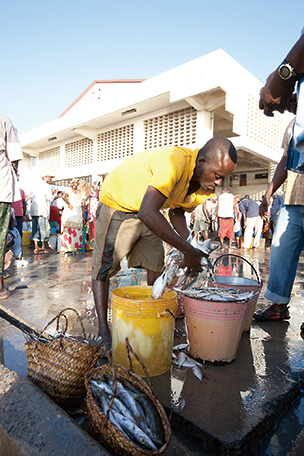
A fish market in Dar Es Salaam, one of the largest cities in Tanzania that faces the Indian Ocean. It was built through the grant aid of Japan in 2002. (Photo: Shinichi Kuno / JICA)
In the 1990s, the end of the Cold War and the advancement of globalization brought to light new issues facing the international community, and various questions were raised with the existing model of development assistance. In particular, peacebuilding, democratization, and governance emerged as new issues that development assistance needed to address. Amidst widening disparities on a domestic and global scale, there was an increasing advocacy for the importance of reducing the poverty of those left behind. Moreover, there were growing calls for further responses to global issues including the environment.
In this context, in 1992, Japan formulated its first ODA Charter, a comprehensive document on Japan's mid- to long-term assistance policy. The ODA Charter presented the basic philosophy of Japan's assistance as follows: (1) humanitarian considerations; (2) recognition of interdependence among nations; (3) environmental conservation; and (4) support for the self-help efforts of developing countries towards economic take-off. Further still, the ODA Charter affirmed that ODA would be provided by paying full attention to recipient countries' situation, including military expenditures, democratization, and the situation regarding the securing of basic human rights.
Japan became the top donor in terms of quantity, and its ODA began to assume greater visibility in various regions of the world. Representative examples of such Japanese initiatives are: Japan's assistance for the rehabilitation, reconstruction, and democratization of Cambodia following its achievement of peace in 1991; and the Tokyo International Conference on African Development (TICAD) process that was kicked off with the holding of the first TICAD meeting in 1993. In the wake of the 1997 Asian financial crisis, Japan pledged up to approximately $80 billion in assistance in relevant countries. This assistance made use of ODA, including assistance based on the New Miyazawa Initiative and special ODA loans, as well as Other Official Flows (OOF). Through such initiatives, Japan spearheaded international assistance in the Asian region.
Japan's ODA was also at the helm of international efforts to tackle global issues, such as the issues of the environment, population, and infectious diseases. Representative examples include: the Kyoto Initiative, Japan's initiative to assist developing countries for combating global warming, which was announced during the Third Conference of the Parties to the United Nations Framework Convention on Climate Change (COP3) in Kyoto in 1997; the Initiative on Women in Development (WID) which was unveiled during the Fourth World Conference on Women in Beijing in 1995; and the Okinawa Infectious Diseases Initiative, an assistance package for fighting infectious diseases totaling $3 billion over five years that was announced at the G8 Kyushu-Okinawa Summit in 2000.
Around this time, Japan further broadened the sphere of ODA partnership with partners, including NGOs, universities, and local governments. In 2000, the Japan Platform (JPF) was launched for the provision of more efficient and prompt emergency humanitarian assistance through the partnership and cooperation of NGOs, the business community, and the Government of Japan.
In addition, Japan played a leading role in the international community's establishment of development goals. The Development Assistance Committee (DAC) of the Organisation for Economic Co-operation and Development (OECD) formulated the so-called DAC NEW Development Strategy – “Shaping the 21st Century: The Contribution of Development Co-operation” – in 1996. Japan led the discussion for the formulation of the Strategy, and the philosophy and policy that Japan's ODA had underscored in its development cooperation were integrated into the Strategy, such as principles of “ownership” and “partnership” (see this), and the importance of institution building, capacity building, and comprehensive approach. In the process of formulating the Strategy, Japan proposed the introduction of numerical targets (International Development Goals [IDGs]) related to poverty reduction and basic human needs (BHN). This in turn led to the establishment of the Millennium Development Goals (MDGs) (see ODA Topics).
Amid the increasingly severe financial situation in Japan, however, Japan's ODA budget began to decline from FY1998 (initial budget base). In 2001, Japan gave up its position to the United States as the world's No. 1 donor in terms of quantity. Accordingly, it became ever more important for Japan's ODA to be implemented efficiently and effectively.
4. Addressing the New Development Challenges of the 21st Century (2000s-Present)
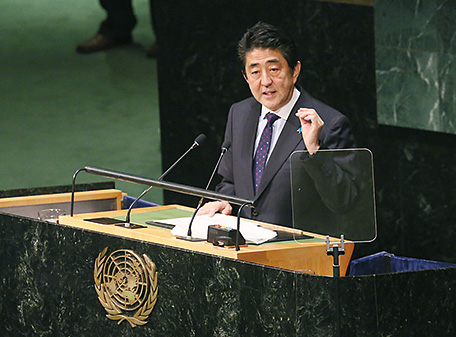
Prime Minister Shinzo Abe delivering an address regarding "the development of society that places people front and center, and promotion of human security" at the 69th session of the UN General Assembly in September 2014.(Photo: Cabinet Public Relations Office)
At the turn of the century a decade after the Cold War ended, the world regrettably saw a further rise in the outbreak of conflicts. Terrorist attacks occurred in the United States in 2001, followed by the use of force against Afghanistan and Iraq. Under these circumstances, the international community began to confront broad and complex challenges in the areas of counter-terrorism, peacebuilding, and governance. Human security emerged as a critical issue in this regard, namely, the question of how to protect people faced with threats, such as conflict and extreme poverty. Global challenges, including the environment, health, and disaster risk reduction, have become more diversified. Meanwhile, more private flows have been heading to developing countries in pursuit of new investment destinations. Emerging economies, such as China and Brazil, are playing a bigger role. While Japan is no longer the world's top ODA donor in terms of scale, as one of the major donors it continues to spearhead development works in the Asia-Pacific region and the international community amidst a largely changing international environment, together with other countries, such as the United States, the United Kingdom, Germany, and France. In the ODA Charter that was revised for the first time in 11 years in 2003, the perspective of “human security” was added, and “poverty reduction,” “sustainable growth,” “addressing global issues,” and “peace-building” were identified as ODA priority issues.
(1) Contribution to International Development Cooperation Trends
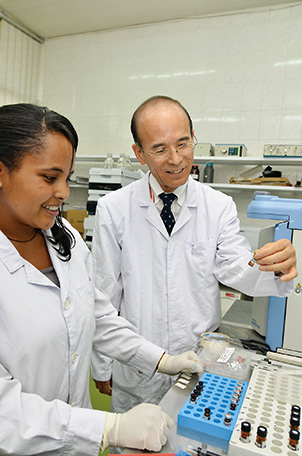
Mr. Yoshio Izawa, who is in charge of the Project for Strengthening of Agricultural Pesticide Residue Analysis System, guiding an assistant to detect agricultural pesticide residues in Ethiopia. (Photo: Takeshi Kuno / JICA)
Japan has proactively contributed to the creation of international ODA trends, while adapting to the changes in the international environment. After the 1994 Human Development Report of the United Nations Development Programme (UNDP) took up the concept of human security for the first time, which, as noted earlier, was considered one of the international priorities of the post-Cold War era, Japan has been actively advocating for this concept on various instances and promoting its further acceptance by the international community. For example, Japan led the initiative to establish the United Nations Trust Fund for Human Security in 1999 and contributed approximately ¥42.8 billion to the Fund up to December 2013. Through this Fund, many projects were implemented, including programs that repaired schools and hospitals in post-conflict Kosovo, rebuilt informal settlements in provincial cities in Afghanistan, and established One-Stop Centres to counteract Violence against Women in South Africa (up to December 2013, the Fund supported 223 projects). Japan has been thereby leading international efforts by taking concrete actions in countries and regions where the human security of individual is threatened by such causes as conflict and disaster.
Gradually, concepts outlined in the basic philosophy and policies of Japan's ODA Charter and other documentation, which grew out of Japan's experience with post-war reconstruction, subsequent economic growth, and providing assistance to Asian countries, gained currency in the international community. The basic view that the recipient country's self-help efforts and “ownership” are important above all else for the growth of the country, and that the role of donors and international organizations is to support this endeavor through “partnership,” has consistently formed the foundation of Japanese assistance. Since the 1990s, Japan has been proactively advocating the importance of “ownership” and “partnership” at international fora, including the aforementioned TICAD process. Moreover, Japan has been consistently giving priority to cooperation in the areas of economic infrastructure development and capacity building to support the sustainable economic growth of developing countries. The premise is that such cooperation will in turn create employment opportunities and income in these countries, which will have a major impact on poverty reduction. In recent years, these concepts have been visibly reflected in international conferences and the development concepts of other donors.
Japan also played a critical role in establishing the MDGs. As mentioned above, Japan led the OECD-DAC's initiative to establish the IDGs, the precursors to the MDGs. The concepts of human security and developing country's “ownership” advocated by Japan formed the basis of the goals that make up the MDGs, such as poverty reduction. The 2000s, which included the adoption of the Paris Declaration on Aid Effectiveness in 2005, saw progress in international initiatives to enhance aid effectiveness, which involved the participation of developed countries, developing countries, international organizations, and the civil society. It has been reaffirmed time and time again that the fundamental principle of developing country's “ownership” underlay this trend. Furthermore, the policies of international organizations, including the World Bank and International Monetary Fund (IMF), and of other donors have increasingly adopted the approach of prioritizing sustainable economic growth for poverty reduction.(Note 6) At international meetings on aid effectiveness and other fora, “triangular cooperation” that Japan has consistently implemented since the 1970s, i.e., cooperation in which developed countries collaborate with developing countries to support other developing countries, has received growing attention as a means for realizing effective aid while maximizing the “ownership” and strengths of developing countries.
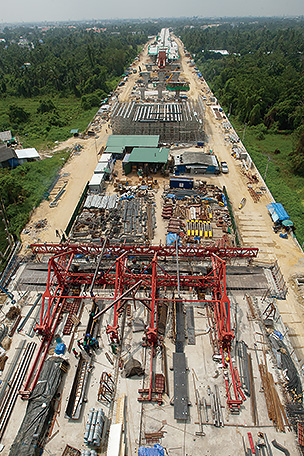
The new Chao Phraya River Crossing Bridge under construction in Nonthaburi Province in the northeast region of Bangkok, Thailand. (Photo: Shinichi Kuno / JICA)
(2) Japan's Leadership in the International Response to Diverse Issues
Japan has exercised leadership in tackling issues of various sectors that have emerged in the new international environment of the 21st century.
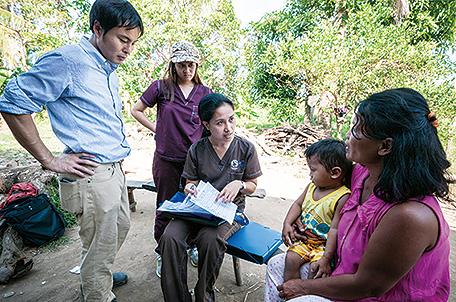
Mr. Raita Tamaki, an expert, conducting home visits with a nurse to investigate the actual conditions of respiratory infections in children in the Philippines (Photo: Mika Tanimoto / JICA)
| Health
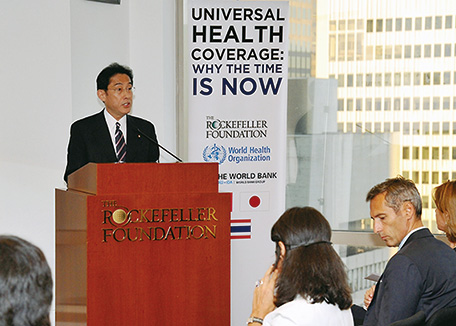
Minister for Foreign Affairs Fumio Kishida addressing a speech at the side event of the 69th session of the UN General Assembly "Delivering on Universal Health Coverage (UHC)" in September 2014.
Japan has consistently taken leadership in the area of health, which has seen various challenges arise with the advancement of globalization, including infectious diseases. As noted earlier, at the G8 Kyushu-Okinawa Summit in 2000 held under Japan's presidency, Japan for the first time identified infectious diseases as one of the main items on the agenda of the G8 summit, and unveiled the Okinawa Infectious Diseases Initiative. This paved the way for the establishment of the Global Fund to Fight AIDS, Tuberculosis and Malaria (the Global Fund) in 2002 (see Part II Health). Japan not only played a leading role in the establishment of the Global Fund, but has also contributed actively to it while playing a central role in the Fund's operation and management as a member of the Board.
The G8 Hokkaido Toyako Summit in 2008, which marked halfway to the deadline to achieve the MDGs by 2015, discussed the importance of new cooperation focusing on health, as well as the sharp increase of global food prices. The Summit compiled the Toyako Framework for Action on Global Health, which outlines the principles for action related to health. Members agreed on actions for health systems strengthening, including infectious disease programs, maternal and child health programs, and the development of health workforce. In May 2013, Japan launched Japan's Strategy on Global Health Diplomacy. In the Strategy, Japan prioritizes global health in its foreign policy, and promotes universal health coverage (UHC) that allows all people to have access to the essential health services they need without suffering financial hardship.
| Disaster Risk Reduction
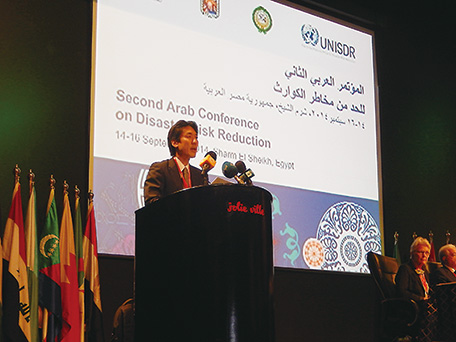
State Minister for Foreign Affairs Minoru Kiuchi announcing Japan's intention to actively cooperate in international disaster risk reduction efforts, at the Second Arab Conference on Disaster Risk Reduction held in Egypt in September 2014.
As Japan has experienced numerous natural disasters, including the Great Hanshin-Awaji Earthquake in 1995 and the Great East Japan Earthquake in 2011, Japan has proactively led the disaster risk reduction effort of the international community, sharing with the world its experiences, lessons learned, and disaster risk reduction technology. Japan has hosted the UN World Conference on Disaster Risk Reduction since its first conference in 1994. At the second conference held in Kobe in 2005, a ten-year international disaster risk reduction guideline through 2015, the Hyogo Framework for Action, was adopted, which has served as disaster risk reduction guidelines in other countries (see ODA Topics). In addition, in response to disasters around the world, including earthquakes, typhoons, and flooding, such as Typhoon Haiyan (Japanese name: Typhoon No. 30; Filipino name: Typhoon Yolanda) which hit the Philippines in 2013, Japan conducts relief activities through emergency humanitarian assistance and also provides recovery and reconstruction assistance. Japan also supports the disaster risk reduction initiatives of developing countries.

Advisor of Landslide Mitigation Project, Mr. Yoshiki Nagai and Mr. Hitoshi Nakazawa (both experts), investigating the landslide affected area in the Abay River Gorge in Ethiopia. (Photo: Kenshiro Imamura / JICA)
| African Development
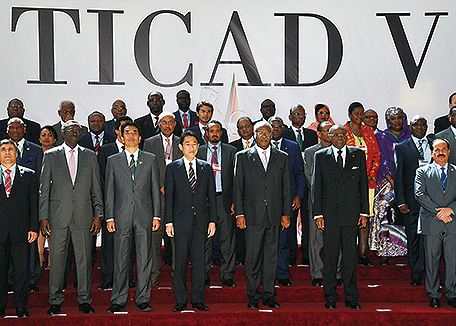
At the First TICAD V Ministerial Meeting held in Cameroon in May 2014.
TICAD, with its first conference in Tokyo in 1993, is an example of an international framework that Japan developed independently from zero, with a view to increasing development effectiveness in Africa. TICAD has served as a pioneering forum for discussing African development with wide-ranging partners, including African countries, development partner countries, international and regional organizations, the private sector, and representatives of the civil society such as NGOs. Since the first conference, five summit meetings have been co-organized in Japan every five years with the UN, UNDP, the World Bank, and the African Union Commission (AUC)(Note 7) under the leadership of the Japanese government. At the fifth conference (TICAD V) in 2013, Japan played an active role in promoting the international community's initiatives for Africa, a continent that aims to overcome its many problems such as conflict and poverty through growth. For example, Japan committed up to approximately ¥3.2 trillion, including approximately ¥1.4 trillion in ODA, in public-private initiatives. Arrangements are being made to hold the next TICAD in Africa.
| Support for Small Island Developing States (SIDS)
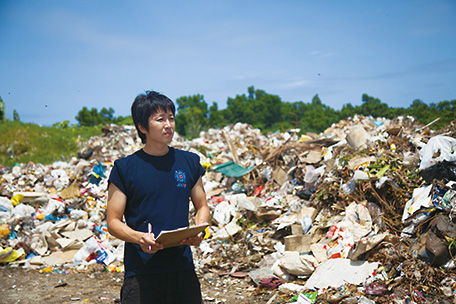
A Japan Overseas Cooperation Volunteer (tourism education), Mr. Takahiro Hamagawa, conducting research in a waste disposal site to improve the waste collection system in Pohnpei, the Federated States of Micronesia. (Photo: Miki Toukairin / JICA)
Small Island Developing States (SIDS) refer to developing countries whose national territory consists of small islands. Such countries are easily affected by disadvantages stemming from their small populations and scattered islands as well as rising sea levels caused by global warming. They are susceptible to damage from typhoon and other natural disasters. Due to their vulnerabilities, sustainable development is a far greater challenge for SIDS than for other developing countries.
Japan has hosted the Pacific Islands Leaders Meeting (PALM) every three years since 1997, attended by the leaders and representatives of the Pacific island countries, Australia, and New Zealand. Japan launched this initiative to promote continuous commitment in cooperation with the Pacific island countries to responses to natural disasters, measures to cope with environmental problems and climate change, protection of the maritime environment, and addressing challenges such as sustainable development. Six leaders' meetings have been held to date.
Through 2014, Japan has also held four Japan-CARICOM Ministerial-Level Conferences with the Caribbean Community (CARICOM)(Note 8) comprised of many SIDS since the first conference in 2000, and the first Japan-CARICOM Summit Meeting was held in July 2014. These meetings have addressed various development issues particular to SIDS. In September 2014, when the Third International Conference on SIDS was held in Samoa to discuss the issues confronting small island states, Japan pledged assistance for the conference's success, including assuming the costs of holding the conference.
| Support for Strengthening ASEAN Connectivity
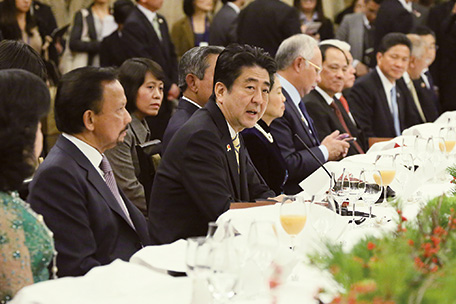
Prime Minister Shinzo Abe delivering greetings at the dinner hosted by the prime minister and Mrs. Akie Abe on the first day of the ASEAN-Japan Commemorative Summit in December 2013. (Photo: Cabinet Public Relations Office)
Japan and ASEAN have forged close cooperative relations over 40 years for the realization of peace, stability, development, and prosperity in the region. Japan's assistance through all the years cover a range of assistance types, from assistance that contributes to the development of farming villages and rural areas and to narrowing the development gap including health and education, to assistance aimed at large-scale infrastructure development, human resources development, and institutional development. This assistance constitutes the bedrock of the current dynamic growth of ASEAN countries.
ASEAN aspires to establish the ASEAN Community in 2015 and identifies enhancing intra-regional connectivity as an absolute priority. Japan has supported ASEAN's efforts to strengthen connectivity by drawing on Japan's experience with infrastructure development and improving the investment environment, from the viewpoint that turning a united ASEAN into a hub for regional cooperation is essential for the region's stability and prosperity. The Meeting between the Japanese Task Force on Connectivity and ASEAN Connectivity Coordinating Committee has been launched. Japan provides assistance for both hard and soft infrastructures that contribute to enhanced regional connectivity, while attaching importance to dialogue with ASEAN. At the ASEAN-Japan Commemorative Summit Meeting in December 2013, Japan pledged ¥2 trillion over five years based on the pillars of strengthening connectivity and narrowing the development gap. Japan will continue to enhance its supports for ASEAN.
| Peacebuilding
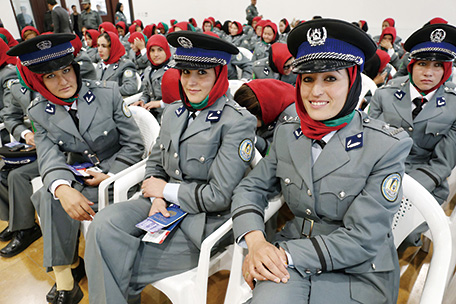
In November 2014, female Afghan police cadets traveled to Turkey to attend training that was provided through the support from Japan. At the International Airport in Kabul, the capital city of Afghanistan. (Photo: Kyodo News)
Japan has made a variety of contributions also in the area of peacebuilding.
Japan has consistently been assisting Afghanistan to ensure that it becomes a self-reliant country and does not become a hotbed of terrorism once again. Under Japan's initiative, the first International Conference on the Reconstruction of Afghanistan was held in Tokyo in 2002. Japan has been supporting Afghanistan's efforts to enhance its capabilities to maintain security, reintegrate ex-combatants into society, and achieve sustainable and self-reliant growth of Afghanistan. Japan's assistance to Afghanistan between October 2001 and April 2014 amounts to approximately $5.4 billion. In July 2012, Japan and Afghanistan jointly held the Tokyo Conference on Afghanistan and released the Tokyo Declaration, which outlined a new partnership between Afghanistan and the international community.
Japan, furthermore, has been actively involved in the peace process in Mindanao, the Philippines, where clashes between the government and Islamic rebel groups continued over many years. Japan dispatched JICA development experts to the International Monitoring Team (IMT) for the Mindanao Peace Process, conducted a scoping survey on the assistance needed in the conflict-affected regions, and translated the survey findings into assistance via ODA in such sectors as education, health, and agriculture. Since 2013, Japan has extended assistances such as institutional building assistance for the new autonomous government and human resources development assistance, looking ahead to the establishment of peace in Mindanao. These supports have earned a high reputation among the local people and government. A comprehensive peace agreement was signed between the government and the Islamic group (MILF: Moro Islamic Liberation Front) in March 2014.
As these representative examples demonstrate, in the 21st century, Japan has continued to proactively exercise leadership as one of the major donors in addressing global challenges, taking stock of Japan's unique experiences and insight.
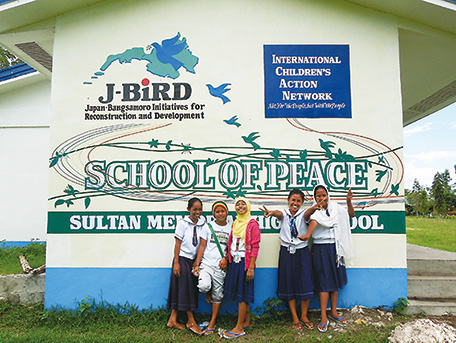
Smiling students in front of the School of Peace in the Philippines, which conducts peace education. (Photo: ICAN)
See this, for more details on the project.
- Note 1: The Colombo Plan, which was proposed in 1950, is a cooperation mechanism for supporting economic and social development of countries in the Asia-Pacific region. As a member of the organization, Japan began providing technical cooperation from 1955 in the form of acceptance of training participants and dispatch of experts.
- Note 2: A dam built in the upstream area of the Kurobe River in Toyama Prefecture.
- Note 3: Assistance that provides funds in grant form to developing countries facing food shortages for the purchase of foods.
- Note 4: Grant aid is a form of financial assistance extended to a developing country or other recipients without an obligation for repayment. Grant Aid for General Projects is assistance provided for the implementation of projects in areas such as basic human needs and education (e.g., building of hospitals and schools and procurement of equipment).
- Note 5: As ODA disbursements include loans, gross ODA disbursements are differentiated from net ODA disbursements, which are gross ODA disbursements minus the loan repayment amount.
- Note 6: The Communiqué adopted at the 87th meeting of the Development Committee of the World Bank and IMF held in April 2013 states as follows: “Achieving this goal (of reducing extreme poverty) will require strong growth across the developing world, as well as translation of growth into poverty reduction to an extent not seen before in many low income countries.”
- Note 7: An executive organization of the African Union (AU), a regional body with 54 African member countries and regions. The AUC represents the AU overseas, proposes policies and legislation, and enforces decisions.
- Note 8: A regional organization with 14 Caribbean member states and 1 member region. The goal of CARICOM is to achieve economic integration in the region. It coordinates the foreign policies among member states, implements common service programs, and extends cooperation for social, cultural, and technical development.
